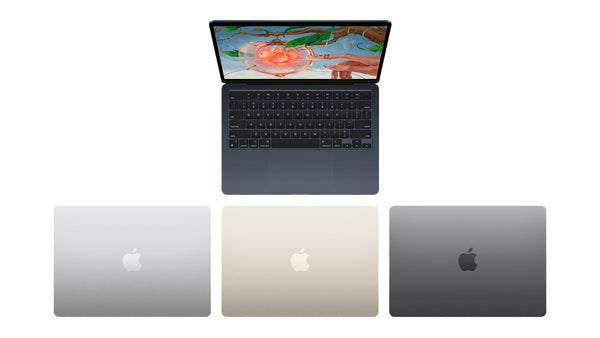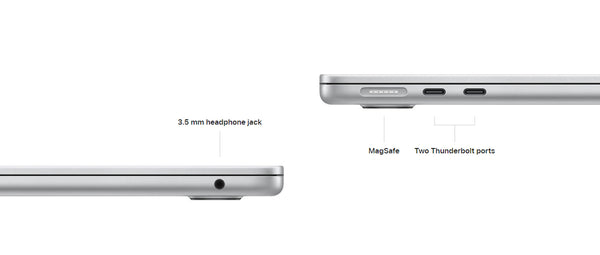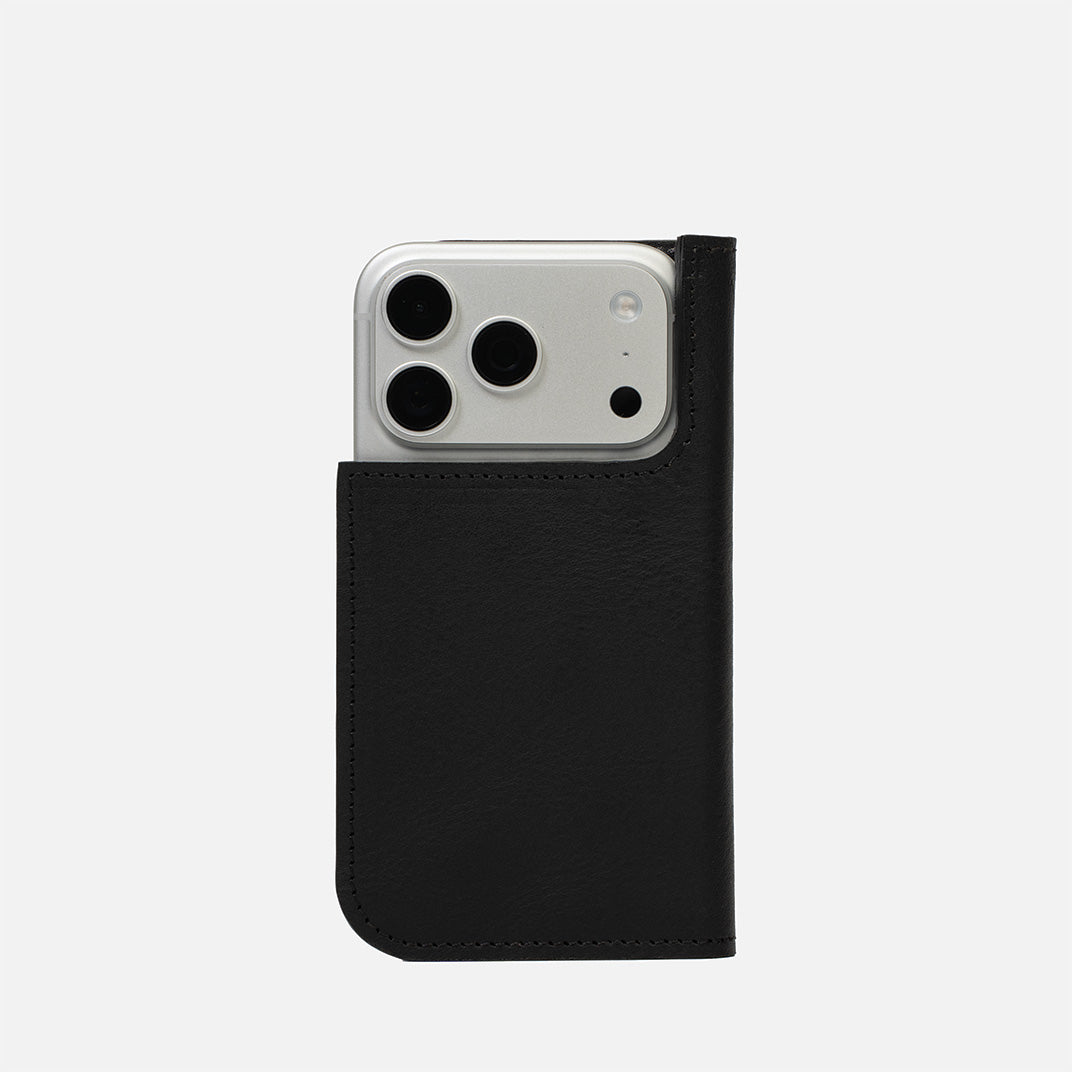
In the ever-evolving landscape of technology, Apple has again raised the bar for innovation and performance with the introduction of its latest MacBook Air models, powered by the groundbreaking M3 chip. This new generation signifies a pivotal moment in Apple's journey, offering a preview of the future of personal computing where supreme efficiency and exceptional performance go hand in hand.
The M3 chip, following the highly praised M1 and M2 chips, marks a significant advancement in Apple's in-house silicon endeavors. Crafted with the needs of both creative professionals and everyday users in mind, the latest MacBook Air models are designed to deliver a computing experience that is not only faster but also more intuitive and environmentally conscious. The chip's enhanced artificial intelligence capabilities and better energy efficiency reflect Apple's dedication to pushing the limits of what's possible while focusing on sustainability.
Available in both 13-inch and 15-inch models, the new MacBook Air lineup caters to a broad spectrum of preferences and requirements. Whether it's for high-end video editing, software development, or casual web browsing, these machines are built to perform tasks with remarkable speed and smoothness. The introduction of the M3 chip is not merely an update to Apple's product range; it represents a redefinition of user expectations from their laptops, establishing new benchmarks for performance, portability, and energy efficiency.
As we explore the details of the design, performance, and special features of these innovative models, it becomes evident that Apple's latest MacBook Air with the M3 chip is not just another product release. It's a forward-looking declaration about the future of personal computing, offering an exciting look into a future where technology continuously enriches our lives, making them more fulfilling, productive, and interconnected than ever.
Aesthetics: Colors, Materials, and Overall Look
The unveiling of the MacBook Air with the M3 chip not only introduces advanced technical capabilities but also showcases significant aesthetic refinements that highlight Apple's dedication to design innovation. These models reflect a thoughtful evolution in style, drawing from customer feedback and Apple's forward-thinking design philosophy.
Colors
The new MacBook Air models are offered in a palette that includes Midnight, Starlight, Space Gray, and Silver. This selection is tailored to suit a range of personal preferences, from the sleek and professional look of Space Gray and Silver to the more unique and striking appearance of Midnight and Starlight. These colors not only add a touch of personalization but also complement the premium finish of the laptops.

Materials Beyond the Aluminum Casing
While the aluminum casing remains a defining feature of the MacBook Air, providing a balance of durability and lightweight design, Apple has also incorporated other sustainable materials. The keyboard uses recycled plastic, and the solder of the main logic board is made from recycled tin, showcasing Apple's commitment to reducing the environmental impact of its products. These materials are carefully selected not only for their sustainability but also for their ability to meet Apple's high standards for quality and performance.
Weight and Thickness
The 13-inch model maintains a profile that is incredibly light at just 2.7 pounds (1.24 kg) and slim at a thickness of 0.44 inch (1.13 cm), making it an ideal companion for users who are constantly on the move. On the other hand, the 15-inch version, despite its larger display, remains remarkably portable, weighing in at 3.3 pounds (1.51 kg) and slightly thicker at 0.45 inch (1.15 cm). These precise dimensions are a testament to Apple's commitment to offering users a balance of performance and portability, ensuring that both models can easily fit into a busy lifestyle without the burden of excess bulk.
Technical Specifications of the M3 Chip
The M3 chip represents a milestone in Apple's silicon development, being the first to utilize the groundbreaking 3-nanometer (3nm) technology process. This advanced manufacturing technique significantly increases transistor density, enhancing both power efficiency and computational performance in a more compact package compared to previous generations.
Performance Benchmarks: Comparison with M1 and M2 Chips
For GPU performance, while the base M3 chip maintains a similar configuration of GPU cores as the M2 and M1 (starting with eight GPU cores that can be upgraded), the real difference lies in the architectural improvements and increased transistor count. The M3 chip benefits from advancements such as Dynamic Caching and support for new rendering technologies, including hardware-accelerated ray tracing and mesh shading. These enhancements promise better performance in graphics-intensive applications, with Apple indicating a substantial increase in peak GPU performance over the M1, and a more moderate yet significant enhancement over the M2.
Specifically, Apple states that the peak GPU performance for the M3 series is up to 65% faster than the M1's. Compared to the M2, the performance increase is more modest but still notable, thanks to the architectural improvements afforded by the 3nm process. This suggests that while users upgrading from the M1 to the M3 will see a more dramatic improvement in GPU performance, those moving from an M2 to an M3 will also benefit from efficiency gains and enhanced capabilities in handling graphics-heavy tasks.
The nuanced performance improvements of the M3 chip reflect Apple's ongoing commitment to pushing the boundaries of what's possible with personal computing hardware, making it an appealing upgrade for users seeking the latest in efficiency and graphical processing power.
AI Capabilities and Enhancements
The M3 chip's 16-core Neural Engine is optimized for advanced machine learning (ML) and AI tasks, offering up to 40% faster ML performance than the M2 chip. This enhancement enables more responsive and intelligent applications, from voice recognition and language processing to photo and video analysis. The M3 chip allows MacBook Air users to experience cutting-edge AI features, including real-time video editing enhancements, more accurate voice commands, and personalized recommendations, all with remarkable speed and efficiency.
Energy Efficiency and Battery Life
One of the most notable achievements of the M3 chip is its enhanced energy efficiency, which contributes significantly to the MacBook Air's long battery life. Despite the substantial increase in performance, the M3 chip's advanced architecture and power management technologies ensure that energy consumption is kept to a minimum. As a result, the MacBook Air with the M3 chip can achieve up to 18 hours of battery life on a single charge, ensuring that users can work, play, and create throughout the day without needing to recharge. This balance of power and efficiency exemplifies Apple's commitment to environmental sustainability and user convenience.
Resolution, Brightness, and Color Accuracy
Both models of the MacBook Air feature Liquid Retina displays, renowned for their crisp resolution, vibrant colors, and high brightness levels. The 13.6-inch model boasts a resolution of 2560 x 1664 pixels, while the 15.6-inch version offers a resolution of 2880 x 1864 pixels, ensuring sharp and detailed visuals across both sizes. The displays achieve brightness levels up to 500 nits, making them perfectly suited for use in a variety of lighting conditions, from dimly lit rooms to direct sunlight.
Color accuracy is another area where the MacBook Air displays excel, covering the wide P3 color gamut that enables more vibrant greens and reds. This wide color support, combined with True Tone technology, which adjusts the display's color temperature based on the ambient lighting, ensures that colors are not only vivid but also natural-looking, reducing eye strain during extended use.
New Display Technology
The MacBook Air with the M3 chip incorporates ProMotion technology, offering an adaptive refresh rate of up to 120Hz. This feature allows for smoother scrolling, more responsive touch input, and enhanced motion clarity, significantly improving the overall user experience, especially in dynamic content like video playback and gaming. ProMotion also adapts the refresh rate to match the movement on the screen, optimizing battery life without compromising display quality.
Additionally, the inclusion of True Tone technology enhances the viewing experience by dynamically adjusting the white balance of the display to match the color temperature of the surrounding light. This makes for a more comfortable viewing experience that is easier on the eyes, particularly during prolonged periods of use.
Types of Ports Available
The MacBook Air models equipped with the M3 chip feature a carefully selected array of ports designed to balance minimalism with functionality. Both the 13.6-inch and 15.6-inch models include two Thunderbolt / USB 4 ports, which support charging, DisplayPort, Thunderbolt 3 (up to 40Gb/s), USB 4 (up to 40Gb/s), and USB 3.1 Gen 2 (up to 10Gb/s). These ports are located on the left side of the machine, providing convenient access for charging and connecting high-speed peripherals.

In addition to the Thunderbolt / USB 4 ports, the MacBook Air also features a 3.5mm headphone jack that supports high-impedance headphones, located on the right side of the device. This inclusion ensures that users can connect a wide range of audio devices for an enhanced listening experience.
Wireless Connectivity Options
Wireless connectivity on the MacBook Air with the M3 chip is robust and future-proof, featuring Wi-Fi 6 (802.11ax) compatibility. Wi-Fi 6 ensures faster wireless speeds, greater network efficiency, and improved performance in environments with many connected devices. Additionally, the MacBook Air supports Bluetooth 5.0, offering enhanced range and speed for connecting wireless peripherals such as mice, keyboards, and headphones, without sacrificing battery life or performance.
Support for External Displays and Peripherals

The MacBook Air equipped with the innovative M3 chip has significantly upgraded its support for external displays and peripherals, aligning with the demands of both professionals and avid users. The incorporation of Thunderbolt / USB 4 ports on the MacBook Air allows connectivity to two external displays, enhancing multitasking capabilities for users. When the laptop lid is closed, it supports a dual external display setup, with the primary display capable of up to 6K resolution at 60 Hz, and the secondary up to 5K resolution at 60 Hz or 4K at 100 Hz, offering an expansive and rich visual workspace crucial for creative professionals, video editors, and those requiring extensive screen real estate.
In addition to superior display capabilities, the MacBook Air's Thunderbolt ports facilitate the connection of a wide array of peripherals, including external storage, docks, and more, ensuring a flexible and productive workflow. While specific support for external GPUs (eGPUs) was not highlighted in the latest updates, the enhanced connectivity options and display support underscore the MacBook Air's position as a versatile and powerful tool for a wide range of applications.
Battery Capacity and Real-World Usage
While specific battery capacity figures in watt-hours (Wh) for the MacBook Air with the M3 chip have not been explicitly detailed, Apple's design optimizations and the efficiency of the M3 chip ensure that these models maintain an impressive balance between power consumption and performance. Real-world usage tests have demonstrated that the MacBook Air with the M3 chip can last up to 18 hours on a single charge for typical tasks such as web browsing, video playback, and word processing. This longevity is a testament to the energy efficiency of the M3 chip and Apple's software optimizations in macOS, which work together to extend battery life under a variety of usage scenarios.
Charging Speeds and Fast-Charging Capabilities
The MacBook Air with the M3 chip supports fast charging, allowing users to quickly replenish the battery's power. With the appropriate USB-C power adapter, users can achieve significant charge levels in a short period—approximately 50% battery capacity in just 30 minutes. This feature is particularly beneficial for users on the go, providing a rapid power boost that ensures the MacBook Air is ready for use when time is of the essence.
Comparison with Previous Models
When compared to the MacBook Air models equipped with the M2 and M1 chips, the MacBook Air with the M3 chip maintains a similar standard of battery life, despite the enhanced performance capabilities of the newer chip. This consistency in battery performance is a remarkable achievement, considering the increased efficiency and computational power offered by the M3 chip. Apple's continued focus on energy-efficient chip design, coupled with macOS optimizations, ensures that users do not have to compromise between performance and battery life.
The introduction of fast-charging capabilities in the MacBook Air lineup, starting with the M1 models and refined in the M3 models, marks a significant improvement over older generations that lacked this feature. This enhancement underscores Apple's commitment to not only maintaining but also improving the user experience with each iteration.
Operating System
The MacBook Air with the M3 chip runs on macOS Ventura, the latest version of Apple's desktop operating system at the time of the device's release. macOS Ventura introduces several new features and improvements that enhance the user experience, including Stage Manager for more efficient multitasking, Continuity Camera which allows an iPhone to be used as a webcam, and enhanced Spotlight search with more powerful search capabilities and quick actions. These features, along with updates to Mail, Safari, and Messages, make for a more connected, productive, and enjoyable computing experience.
Pre-installed Software and App Compatibility
Each MacBook Air comes with a range of pre-installed apps that cater to various needs, from creativity and productivity to entertainment. These include Pages, Numbers, Keynote for document creation and management, iMovie and GarageBand for media editing, and FaceTime and Messages for communication. The MacBook Air with the M3 chip also benefits from the App Store's vast selection, offering millions of apps across categories, ensuring users have access to the tools they need.
App compatibility is a strong point for the MacBook Air, thanks to the architecture of the M3 chip. Most apps designed for macOS run natively, while others, including many developed for Intel-based Mac systems, continue to operate smoothly via Rosetta 2 translation. This wide compatibility ensures a seamless transition for users upgrading from older models and provides developers with a robust platform for creating innovative applications.
Pricing and Availability
13-Inch MacBook Air (M3)
The 13-inch model offers three primary configurations:
- $1,099: Equipped with an M3 chip with an 8-core GPU, 8GB RAM, and a 256GB SSD.
- $1,299: Upgrades to a 10-core GPU, with 8GB RAM and a 512GB SSD.
- $1,499: Features a 10-core GPU, 16GB RAM, and a 512GB SSD.
Upgrade options for the entry-level 13-inch MacBook Air include:
- An additional $100 for a 10-core GPU, up to $400 for 24GB Unified Memory, and up to $800 for 2TB SSD storage.
Middle-tier and higher-end configurations allow for upgrades to 24GB Unified Memory and up to 2TB of SSD storage, with costs varying based on the starting configuration.
15-Inch MacBook Air (M3)
The 15-inch MacBook Air is also available in three configurations:
- $1,299: Comes with a 10-core GPU, 8GB RAM, and a 256GB SSD.
- $1,499: Offers a 10-core GPU, 8GB RAM, and a 512GB SSD.
- $1,699: Includes a 10-core GPU, 16GB RAM, and a 512GB SSD.
Upgrade options for the 15-inch model mirror those of the 13-inch, with added costs for increased Unified Memory and SSD storage capacity. Notably, both 13-inch and 15-inch models can be configured with up to 24GB of Unified Memory and up to 2TB SSD, catering to users who need more power and storage.
It's worth mentioning that Apple continues to sell the M2 MacBook Air, providing an option for users looking for a more budget-friendly choice starting at $999 for the base model with an 8-core CPU, 8-core GPU, 8GB RAM, and a 256GB SSD.
M3 vs M1 Pro & M1 Max
When comparing the MacBook Air with the M3 chip to MacBook Pro models equipped with more powerful M-series chips like the M1 Pro and M1 Max, several key aspects highlight the intended use cases and performance capabilities of these devices.
Performance
- CPU and GPU Performance: The MacBook Pro models with M1 Pro and M1 Max chips offer significantly higher performance due to more CPU and GPU cores. This translates to better handling of intensive tasks like video editing, 3D modeling, and software development. For instance, MacBook Pro models with these chips show a noticeable improvement in multitasking, faster rendering times, and smoother playback in demanding applications.
- Neural Engine and AI Capabilities: While the M3 chip in the MacBook Air offers a faster Neural Engine compared to the M2, the M1 Pro and M1 Max chips provide even more robust AI and machine learning capabilities. This is crucial for professional workflows involving AI-driven tasks, such as voice recognition, photo and video editing, and more complex computational tasks.




